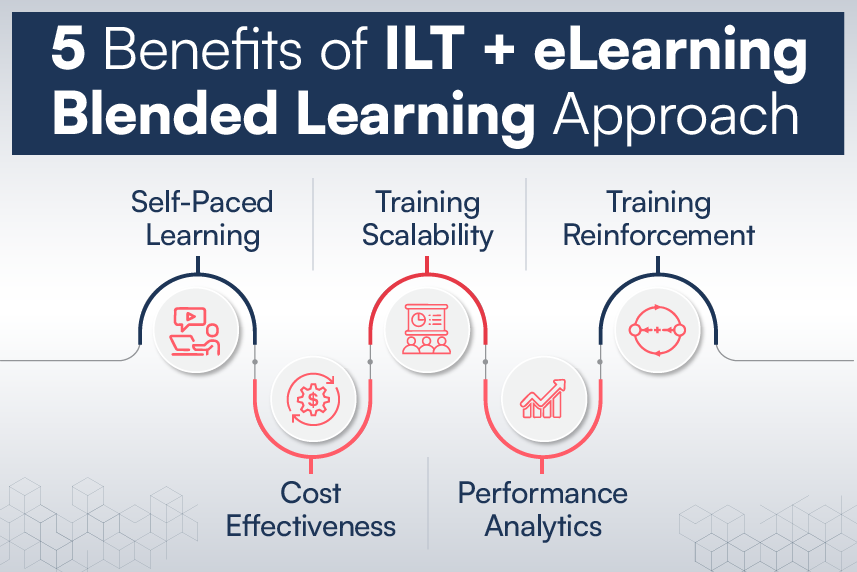
The way learning is delivered directly impacts performance and retention. Traditionally, it has been done through classroom-based, Instructor-led training (ILT) sessions which efficiently met relevant learning objectives. However, with rapid advancements in technology, increased geographic reach of organizations, changed learner profiles because of inclusion of millennials in the workforce and tech-savvy learners, there is a huge scope for ILT to be made more effective. ILT will work best if it is part of a blended learning program that supplements ILT with eLearning, making it a more cost-effective, and hence, justified proposition.
The blended learning approach could follow the below format.

- An introductory eLearning aid can be used to apprise learners of the basic concepts of the topic-in-picture. This would ensure that all learners are on the same page when it comes to the basics of the topic.
- Pre-ILT practice sessions can then be used to gauge learner understanding of the topic so that the instructor could build on it during the actual session.
- When the ILT is delivered, it could be used to build upon the topic knowledge and to clarify any doubts that the learners may have. The classroom time can also be used to discuss relevant case studies on the topic.
- And then an eLearning assessment comes in to test learner understanding and knowledge. eLearning could also be used to nudge training concepts from time to time and act as a good refresher to the classroom sessions.
There are several benefits of the blended learning approach versus when you use only ILT. Let’s talk about some prominent ones.
Aids Self-Paced Learning
A study on “Interactive Multimedia-Based E-Learning: A Study of Effectiveness”[1] stated, “In a traditional classroom setting, learning is instructor-centered and is a sequential process. The instructor controls content and learning pace. Most students do not question or ask for repetition in the class even if they do not understand instructors. In addition, they do not have an opportunity to listen repeatedly to what instructors explained. An interactive multimedia e-learning environment enables learner-centered activities and provides necessary learner–content interaction.” eLearning puts the learners in control of the content, making it easier for everyone to learn at their own pace.
Cost-Effective and Easily Scalable
With increasing geographic scale and reach of organizations, training needs to be delivered to employees at multiple locations. But at the same time, travel budgets are continuously constrained. eLearning can be delivered anytime and at anyplace, thus making it easier to keep travel costs and time in control. It also gives an opportunity to trainers to scale up their training bandwidth and scope in a matter of seconds. Trainers could simply complement eLearning with synchronous online learning sessions or virtual ILT.
Performance Evaluation
ILT is linked with too many missed opportunities to evaluate everything right from training objectives to learner performance and satisfaction. Whereas eLearning ensures that you get to measure and evaluate learner performance and its impact on business, with the help of rich analytics. With learner experience design posed as the next big revolution for learning, performance analytics and evaluation will anyway need to be at the core of enterprise learning.
Supports Reinforcement
Traditional training, once delivered, is easily forgotten, because there is no system in place for regular reinforcement and retention. However, with eLearning, regular refreshers and reinforcement nuggets can be delivered based on learner performance or the likelihood of learner forgetting information after a certain time.
Needless to say, eLearning is not here to replace SMEs and trainers. They will still be the ones driving the whole game. eLearning can give them an opportunity to take their work a level higher, along with probably an added revenue source when their hands are full. Something as simple as a video of them teaching a particular concept in the classroom, coupled with eLearning could do the magic!
Are you a trainer looking to develop blended learning modules? Reach out to us at contact@harbingergroup.com to discuss your requirements.






